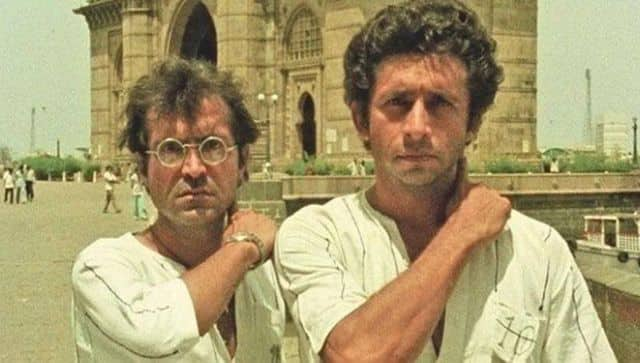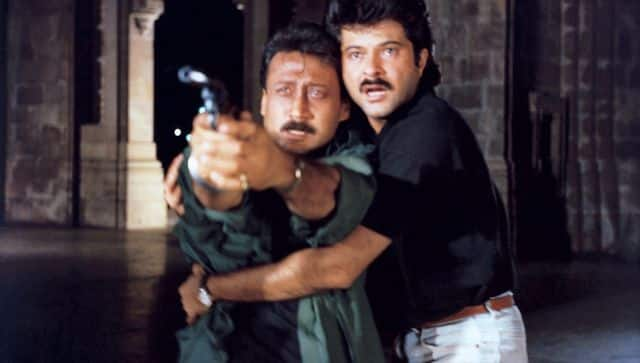Of all the eras that Hindi cinema has survived through, the decade of 1980s is maligned the most. It often gets a bad rap for the perceived erosion in the quality of filmmaking and is associated with asinine action films and cringe worthy content. Overall, the 80s are frequently charged with being the most creatively bankrupt phase in the whole history of movies in India. There might actually be some truth in this. Hindi film industry was going through a midlife crisis. Many big films were biting the dust, the middle class had stopped going to theatres, which were turning into seedy, unwelcome places, and the Bachchan juggernaut seemed to be slowing down (little did we know). But to gain some perspective, you need the luxury of time. Today, looking back at the decade of disco, Doordarshan and denim, one can say it wasn’t all that bad – at least as far as cinema is concerned. The meteoric rise of the south remakes, innuendo-filled lyrics and bad writing dominates our memory when we try to remember the 80s, but it wasn’t all that simple. In fact, 80s may well one of the most interesting eras in Hindi film history! How, you ask? Let’s dig in. Well begun, as they say, is half done The decade began on a great note with Sai Paranjpye’s Sparsh, which was released on 30th January 1980. Naseer and Shabana were in top form. Trivia mongers claim that Al Pacino saw Naseer’s portrayal of a blind Anirudh Parmar before playing Lt. Col. Frank Slade in Scent of a Woman (1992). The film also had the fabulous Om Puri and the very underrated Mohan Gokhale. Close on the heels of Sparsh came Hrishikesh Mukherjee’s Khubsoorat (1980). It was a breath of fresh air…it was a window that opened into a garden of lilies. It remains one of Hrishikesh Mukherjee’s more popular works, and one of the two films he had cast Rekha in. 1980 was also the year of stylish, Bond-inspired action flicks such as Dostana, Qurbani and Shaan, all of which had a great impact on the genre. 1981 brought Bachchan’s Kaalia, Yaarana, Naseeb, Laawaris, and Manoj Kumar and Dilip Kumar’s blockbuster Kranti. If you are still on the fence about what a great beginning the 80s had, I have two other titles for you: Chashme Buddoor and Silsila. [caption id=“attachment_10938311” align=“alignnone” width=“640”]  Jaane Bhi Do Yaaro[/caption] It was the golden age of nepotism I know the N-word is all the rage now, with highly conscientious Internet warriors throwing a fit at the very utterance of the word. But the 80s were different, you see. The audiences were less fussy about the movies. They were just interested in wide-eyed enjoyment of whatever was unfolding on screen. In fact, they actually looked forward to star kids being launched. If you were a Dharmendra fan, you couldn’t wait to see what his son, a mini-Dharmendra, can do on screen. Betaab (1983) was a sensation and lent its name to a whole valley in Kashmir! Rocky (1981) had an equally encouraging reception. Besides Dharmendra and Sunil Dutt, children of Raj Kapoor, Dev Anand, Manoj Kumar, Rajendra Kumar, Shashi Kapoor, Mahendra Kapoor, Tahir Hussain, Salim Khan, Tabassum and many others were launched during this period. It was the golden age of Doordarshan Doordarshan had come into existence in 1959, but 80s witnessed the beginning of the television revolution. Most middle-class families (or neighbourhood) had one. Doordarshan had germinated into this institution which actively promoted new talent and interesting new concepts. Past, present and future filmmakers sharpened their tools on TV serials. Lekh Tandon, Shyam Benegal, Gulzar, Aziz Mirza and even Hrishikesh Mukherjee were making serials. TV and cinema fed off each other. Chitrahar laid the foundations of film-love in the hearts of a generation of kids and teenagers who went on to make films themselves. DD also broadcast Hindi movies every Saturday and Sunday evenings, and regional films on Sunday afternoons. There was no Internet, DVDs hadn’t arrived yet and renting VHS cassettes was too expensive to keep doing it every time you wanted to watch a movie. The national broadcaster introduced young Indians to a whole array of not only Hindi or regional, but also world cinema. [caption id=“attachment_10938341” align=“alignnone” width=“640”]  Parinda[/caption] Love story(s) 80s were also when romance bloomed. Bobby (1973) may have started the trend of young love stories, but it truly came to its own in the 80s. And most/ all of these films launched newcomers. A decade that began with Kumar Gaurav (Love Story, 1981) ended with Salman Khan (Maine Pyar Kiya, 1989). It saw the “introduction” of the already legendary Kamal Hassan (Ek Duuje Ke Liye, 1981) and the debut of boy-wonder Aamir Khan (Qayamat Se Qayamat Tak, 1988). The credits of QSQT said introducing Aamir Khan and yet, he was credited by his birth name Aamir Hussain four years earlier in another quintessential 80s film called Holi (1984). Same goes for the film’s heroine Juhi Chawla who shared the introducing credit with Aamir in QSQT but also shared the same credit with Shashi Kapoor’s son Karan Kapoor two years earlier in Sultanat (1986). Hero (1983) ushered in the Age of Jackie Shroff, and Rajeev Kapoor and Mandakini walked into the sunset at the end of Ram Teri Ganga Maili (1985). 80s was also the decade of Prem Rog (1982), Saagar (1985) Chandni (1989). Interestingly, all three included Rishi Kapoor, who was the ubiquitous lover boy throughout the 80s. One word: Sridevi Need I say anything else? If there was one word that could conclusively prove that the 80s were a superlative decade, it has to be Sridevi. Having conquered Tamil and Telugu cinema, Sridevi made landfall in Bombay like a veritable comet. Solva Sawan (1979) was a disaster, but that was a distant memory when she went on a rampage throughout the 80s, delivering hits like an afterthought. The 16 blockbusters she did with Jeetendra included Himmatwala (1983), Jaani Dost (1983), Maawali (1983), Tohfa (1984), Dharm Adhikari (1986) and a plethora of other Telugu remakes. But if there were two films which made the 80s her decade and her alone, they were Mr.India (1987) and Chandni (1989). She dominated the decade. The heroes – often huge stars – seemed puny in her presence. She barely spoke outside the sets, but as soon as the camera pointed at her, she transformed into the goddess she was. Parallel cinema boom While the parallel or new cinema movement came to Hindi cinema in the 70s, it really flowered in the 80s. Inspired by Shyam Benegal’s forays into stark, realist cinema, Govind Nihalani broke into filmmaking with his classic Aakrosh (1980) where he let panthers like Naseer and Om loose into an unsuspecting audience. With Vijeta (1982), Ardh Satya (1983) and Party (1984), he went from strength to strength. Especially Ardh Satya was a visceral scream from the gut, a film that remains a high watermark for modern filmmakers to aspire to. Nihalani made 5 films during the 80s. Apart from Vijeta (which I believe was Top Gun for grownups), each one of the other four included the pair of Om Puri and Naseeruddin Shah in varying degrees. As for Benegal, he too was in the prime of his creativity during the 80s. Pick any one from Kalyug (1981), Arohan (1982), Mandi (1983), Trikaal (1985) and Susman (1987). And then there was Saeed Akhtar Mirza’s Albert Pinto ko Gussa Kyon Aata Hai (1980), Mohan Joshi Hazir Ho! (1984), and Salim Langde Pe Mat Ro (1989), Mahesh Bhatt’s Arth (1982) and Saaransh (1984), Vijaya Mehta’s Pestonjee (1988), Aruna Raje’s Situm (1988) and Rihaee (1988), Mani Kaul’s Satah Se Uthata Aadmi (1980), Kumar Shahani’s Tarang (1984) and Khayal Gatha (1989), Jabbar Patel’s Umbartha (1982), Ketan Mehta’s Bhavni Bhavai (1980) and Mirch Masala (1985), Gautam Ghose’s Paar (1984) and Mrinal Sen’s Khandhar (1983), Genesis (1986) and Ek Din Achanak (1989)…all of them came out into the world back in the 80s. Also - it might not be an exaggeration to call 1983 “the year of Naseeruddin Shah”. That same year, he had the following releases in Hindi: Ardh Satya, Masoom, Mandi, Woh Saat Din, Katha, and Jaane Bhi Do Yaaro. Corruption and 80s action films If post-independence disillusionment and the desperation of Emergency brought forth the Angry Young Man in the 70s, rampant corruption and hooliganism became a recurring theme in cinema of the 80s. Rahul Rawail who helmed the debut of Sunny Deol with Betaab (1983), launched him in a completely different avatar with Arjun (1985). Arjun Malvankar remains one of the most author-backed and stark roles that Deol ever portrayed. A naïve young man who wanted to be good and do good was transformed into a vigilante. It was also one of the earliest depictions of the nexus between cops and politicians. This nexus is also the mainstay in Dilip Shankar’s underrated classic Kaal Chakra (1988), where Suresh Oberoi turns in a solid performance as an honest cop trapped in this rotting system. A similar underappreciated gem is Sujata Mehta’s debut vehicle Pratighaat (1987) in which Sujata’s Laxmi Joshi, raped and humiliated, fights back tooth and nail against the goon turned politician Kali Prasad (Charan Raj). Pratighaat’s director N. Chandra or Chandrashekhar Narvekar has dealt with this theme time and again. Ankush (1986), his debut, was a searing tale about four unemployed young men wasting away their life, when a woman they know is gang-raped and the perpetrators go scot-free. Frustrated with the system but finally with a purpose in life, they give the rapists hell. Dirty cops and dirtier politicians was a surprisingly common theme in mainstream Hindi cinema of the time, and even the great Bachchan was seen fighting this unholy combine in Inquilaab and Aakhree Raasta (1986). Birth of the Bombay gangster film When did gangster films really make inroads into Hindi cinema? While gangsters have always been seen in our films, that kind of gangster film which shows the inner workings of a gang, or two gangs going to war, is something that Hindi film industry warmed up to only in the 80s. Though Deewaar (1975) could have been that film, its ambition was different. Two 1989 films seem to fall squarely in that category: J.P. Dutta’s Hathyar and Vidhu Vinod Chopra’s Parinda. Unlike Dutta’s other films which are essentially set in Rajasthan, Hathyar is an urban drama that unfolds in the underbelly of 1980s Bombay (though it does begin in Rajasthan). It is a gem of a film that doesn’t nearly get as much love as it deserves. Parinda, on the other hand, has been hailed as a gangster classic which paved the way for the future Mumbai Noir films of RGV. Both Arjun and Ardh Satya, while not being gangster’s films, depict crime and gangsters in a way that was not thought of in earlier decades. Rama Shetty’s seedy hideout and the matka dens that Arjun Malvankar and his friends demolish, look as real as can be. This whole idea of labelling the 80s as the worst period of Hindi cinema seems overly simplistic and inaccurate. And it is also naïve to reduce the entire decade to disco, bling and the south remakes. The sheer variety and expanse of films make the 1980s one of the most fascinating periods in the history of Indian movies. Amborish is a National Film Award winning writer, biographer and film historian. Read all the **_Latest News_** _,_ **_Trending News_** _,_ **_Cricket News_** _,_ **_Bollywood News_** _,_ **_India News_** and **_Entertainment News_** here. Follow us on Facebook_,_ Twitter and Instagram
The 80s gets a bad rap when it comes to the cinematic output associated with the period. It’s the worst era for Hindi cinema, film buffs often declare. But the truth is very different.
Advertisement
End of Article


)
)
)
)
)
)
)
)
)



